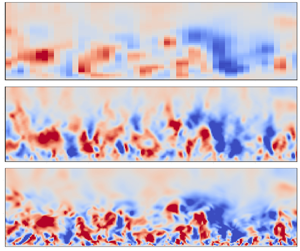No CrossRef data available.
Article contents
High-flexibility reconstruction of small-scale motions in wall turbulence using a generalized zero-shot learning
Published online by Cambridge University Press: 14 August 2024
Abstract

This study proposes a novel super-resolution (or SR) framework for generating high-resolution turbulent boundary layer (TBL) flow from low-resolution inputs. The framework combines a super-resolution generative adversarial neural network (SRGAN) with down-sampling modules (DMs), integrating the residual of the continuity equation into the loss function. The DMs selectively filter out components with excessive energy dissipation in low-resolution fields prior to the super-resolution process. The framework iteratively applies the SRGAN and DM procedure to fully capture the energy cascade of multi-scale flow structures, collectively termed the SRGAN-based energy cascade reconstruction framework (EC-SRGAN). Despite being trained solely on turbulent channel flow data (via ‘zero-shot transfer’), EC-SRGAN exhibits remarkable generalization in predicting TBL small-scale velocity fields, accurately reproducing wavenumber spectra compared to direct numerical simulation (DNS) results. Furthermore, a super-resolution core is trained at a specific super-resolution ratio. By leveraging this pretrained super-resolution core, EC-SRGAN efficiently reconstructs TBL fields at multiple super-resolution ratios from various levels of low-resolution inputs, showcasing strong flexibility. By learning turbulent scale invariance, EC-SRGAN demonstrates robustness across different TBL datasets. These results underscore the potential of EC-SRGAN for generating and predicting wall turbulence with high flexibility, offering promising applications in addressing diverse TBL-related challenges.
- Type
- JFM Rapids
- Information
- Copyright
- © The Author(s), 2024. Published by Cambridge University Press





